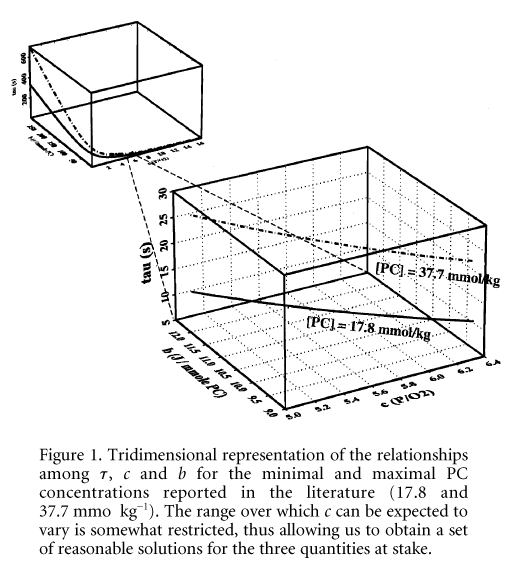The aim of the present study was to show that it is possible to gain information on variables traditionally assessed during exercise transients from data obtained at steady state. A theoretical model is described, which shows that oxygen consumption above resting (Δ O2), mechanical power (W) and phosphocreatine (PC) concentration at steady state are set by the time constant of the O2 on response (t), the O2 equivalent of high energy phosphate splitting (c) and the mechanical work performed per unit of PC split (b). The model assumptions are as follows: (i) the muscle O2 on response is monoexponential and (ii) it mirrors the fall of PC concentration (ΔPC), (iii) throughout the exercise lactic acid production is nil. If this is so: ΔPC/Δ O2 = ct; Δ O2/W = (bc)-1 and ΔPC/W = t/b. Thus in the three-dimensional space (c, b, t) the experimental quantities ΔPC/Δ O2, W/Δ O2 and ΔPC/W define a function where all triplets (c, b, t) compatible with the experimental data must lie.
The range of c, t and b was assessed on ten healthy volunteers performing rhythmic (0.83 Hz) dynamic exercise with the calf muscles of both legs (Francescato & Cettolo, 2001) inside the bore of a standard 1.5 T MR unit. W and Δ O2 were measured at steady state and relative PC concentration (ΔPC) was simultaneously evaluated by 31P-MR spectroscopy from the medial belly of the right gastrocnemius. Δ O2 and W were expressed per unit of active muscle mass, as measured by MRI in separate experiments.
The relationships between Δ O2 (mmol kg-1 s-1) and W (Watt kg-1), between ΔPC and W and between ΔPC and Δ O2 can be appropriately interpolated by straight line regressions, as described by: Δ O2 = 5.23 X 10-3 + 16.8 X 10-3 W (r = 0.952), ΔPC = 0.0596 + 0.0625 W (r = 0.861) and ΔPC = 0.0412 + 3.71 Δ O2 (r = 0.898).
These data allowed us to calculate the inter-relationships among the three quantities c, t and b; they are represented tridimensionally in Fig. 1 for the minimal and maximal PC concentrations to be expected in resting muscle (17.8 and 37.7 mmol kg-1 fresh muscle; Rico-Sanz et al. 1999; Walter et al. 1999). Figure 1 shows that, for an O2 equivalent of PC splitting (P/O2 ratio) not far from 6, the mechanical equivalent of PC splitting is unaffected by resting PC concentration, amounting to about 10 J mmol-1, whereas the time constant of the O2 uptake at work onset increases with PC concentration from 10 to 25 s.
These data support the view that the steady-state energetics are dependent on, and tightly coupled to, the events that occurred during the transient phase, of which the steady state can therefore be considered the ‘memory’.
All procedures accord with current local guidelines.

